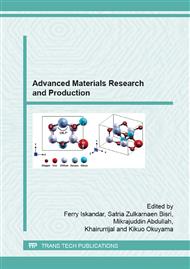p.262
p.266
p.271
p.275
p.279
p.282
p.286
p.290
p.294
Effect of Al2O3 on the Electrical Conductivity of MgI2-Mg3(PO4)2 Solid Electrolyte
Abstract:
MgI2 and Mg3(PO4)2 were mixed in varied compositions and the mixture was subjected to ball milling and sintering process. The optimum composition of the binary system with the maximum conductivity of 5.72 x10-4 Scm-1 at room temperature was obtained and used to study the effect of ceramic filler. A small amount of Al2O3 was added to the 0.7 Mg3(PO4)2 0.3 MgI2. The effect of ceramic filler on the electrical conductivity of the binary compound is investigated by Electrical Impedance Spectroscopy (EIS) technique in the frequency range from 50 Hz to 1 MHz. The conductivity was enhanced to 1.08 x 10-3 Scm-1 when 4 wt. % of Al2O3 was added. Further characterization was performed by using Infrared (FTIR) technique. From FTIR spectra, the variation in the peak intensity and shifting were observed which is due to the interaction between O-OH on the filler grain surface.
Info:
Periodical:
Pages:
279-281
Citation:
Online since:
July 2015
Authors:
Price:
Сopyright:
© 2015 Trans Tech Publications Ltd. All Rights Reserved
Share:
Citation:


